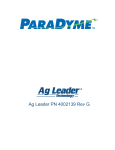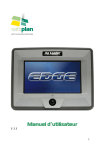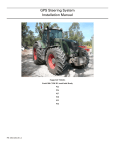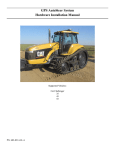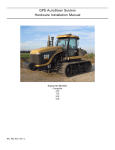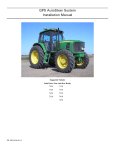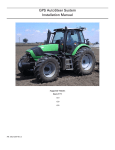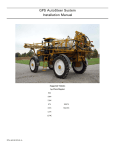Download 602-0271-01
Transcript
ParaDyme Upgrade for Trimble Valves Installation Manual Application: Vehicles with a Trimble Valve Installed PN: 602-0271-01-A LEGAL DISCLAIMER Note: Read and follow ALL instructions in this manual carefully before installing or operating the AutoSteer system. Note: Take careful note of the safety information in the Safety Information section and throughout this manual. The manufacturer disclaims any liability for damage or injury that results from failure to follow the instructions and warnings set forth herein. Please take special note of the following warnings: 1. There is NO obstacle avoidance system included in the manufacturer’s product. Therefore, users must always have an operator on the equipment when the AutoSteer system is in use to look for any obstacles including people, animals, trees, ditches, buildings, etc. 2. During installation of the AutoSteer system and during the Calibration and Tuning processes the vehicle's wheels (or tracks) turn and the vehicle moves. Be sure that all people and obstacles are clear of the vehicle before installation, calibration and tuning, or use of the AutoSteer system. 3. Use of the AutoSteer system is NOT permitted while the vehicle is on public roads or in public areas. Ensure that the system is OFF before driving on roads or in public areas. Required Tools This list consists of the tools required to complete the installation. The installer is assumed to have a complete set of common installation tools. 3/4” open wrench #2 Phillips screwdriver Cleaning brush Cleaning rags ii AutoSteer System Safety Information Warning Alerts The AutoSteer system installer and manufacturer disclaim any responsibility for damage or physical harm caused by failure to adhere to the following safety requirements: • • As the operator of the vehicle, you are responsible for its safe operation. The AutoSteer system is not designed to replace the vehicle’s operator. Note: Verify all screws, bolts, nuts, and cable connections are tight after the final installation of the AutoSteer system on the vehicle. WARNING To avoid electrical shock hazards, remove the Roof Module from the vehicle before driving under low structures or low electrical power lines. WARNING To prevent injury from falling, ensure you are in a stable position on the vehicle when installing or removing the Roof Rail and Roof Module. If the vehicle does not provide a safe platform, use a ladder to safely access the vehicle roof while installing or removing the Roof Rail and Roof Module. WARNING To prevent accidental death or injury from being run over by the vehicle, never leave the vehicle's operator chair with the AutoSteer system engaged. Hardware Installation Manual iii WARNING High-Pressure Fluid Hazard Read this manual before installation. Wear hand and eye protection while performing hydraulic system maintenance. Relieve hydraulic system pressure before servicing the hydraulic system. WARNING To understand the potential hazards associated with the operation of AutoSteer system equipment read the provided documentation before installing the AutoSteer system on a vehicle. WARNING To prevent the accidental engagement of AutoSteer and loss of vehicle control while driving on roads, shut down the AutoSteer system (exit the program). Never drive on roads or in public areas with the AutoSteer system turned on. WARNING Do not stand close to the wheels and do not move the machine while you are servicing the steering valve. Turn off the engine and engage the parking brake before standing under or next to the machine. iv AutoSteer System Caution Alerts The AutoSteer system installer and manufacturer disclaim any responsibility for damage or physical harm caused by failure to adhere to the following safety requirements: CAUTION The Roof Module must be removed when transporting or driving the vehicle at speeds above 30 mph (50 km/h). The Roof Module can possibly detach due to wind loads at higher speeds. CAUTION The AutoSteer system does not detect obstacles in the vehicle’s path. The operator must observe the path being driven in order to avoid obstacles. CAUTION When engaged, the AutoSteer system controls only the steering of the vehicle. The operator must control the speed of the vehicle. CAUTION The AutoSteer system must be powered OFF when installing or removing the Roof Module. CAUTION The Roof Module must always be firmly secured to the Roof Rail using the hardware whenever the vehicle is in operation to prevent the Roof Module from releasing from its bracket and falling. Hardware Installation Manual v Important Information Note: Verify all screws, bolts, nuts, hose connections, and cable connections are tight after the final installation of the AutoSteer system on the vehicle. Technical Support Refer to your Display user manual for technical support information. Contact Information Refer to your Display user manual for contact information. Copyright Information Trimble is a registered trademark of Trimble Navigation Limited. Copyright © 2010 All Rights Reserved. vi AutoSteer System Table of Contents Chapter 1 Installation Overview....................................................................................... 1 Installation Procedure Outline . . . . . . . . . . . . . . . . . . . . . . . . . . . . . . . . . . . . . . . . . . . . . . . . . 2 Kit Overview . . . . . . . . . . . . . . . . . . . . . . . . . . . . . . . . . . . . . . . . . . . . . . . . . . . . . . . . . . . . . . . 3 Kit Components . . . . . . . . . . . . . . . . . . . . . . . . . . . . . . . . . . . . . . . . . . . . . . . . . . . . . . . . . . . 3 Common Kit . . . . . . . . . . . . . . . . . . . . . . . . . . . . . . . . . . . . . . . . . . . . . . . . . . . . . . . . . . . . . 4 Adapter Cable Kit . . . . . . . . . . . . . . . . . . . . . . . . . . . . . . . . . . . . . . . . . . . . . . . . . . . . . . . . . 5 Chapter 2 Valve Identification and Inspection .................................................................... 7 Valve Identification . . . . . . . . . . . . . . . . . . . . . . . . . . . . . . . . . . . . . . . . . . . . . . . . . . . . . . . . . . 7 Valve Identification Procedure . . . . . . . . . . . . . . . . . . . . . . . . . . . . . . . . . . . . . . . . . . . . . . . 8 Valve Inspection . . . . . . . . . . . . . . . . . . . . . . . . . . . . . . . . . . . . . . . . . . . . . . . . . . . . . . . . . . . 10 Chapter 3 Installations Using a Pressure Transducer......................................................... 11 Overview . . . . . . . . . . . . . . . . . . . . . . . . . . . . . . . . . . . . . . . . . . . . . . . . . . . . . . . . . . . . . . . . . 11 Installation Procedure . . . . . . . . . . . . . . . . . . . . . . . . . . . . . . . . . . . . . . . . . . . . . . . . . . . . . . . 12 Chapter 4 Installations Using a Flow Switch.................................................................... 17 Overview . . . . . . . . . . . . . . . . . . . . . . . . . . . . . . . . . . . . . . . . . . . . . . . . . . . . . . . . . . . . . . . . . 17 Installation Procedure . . . . . . . . . . . . . . . . . . . . . . . . . . . . . . . . . . . . . . . . . . . . . . . . . . . . . . . 18 Hardware Installation Manual vii viii AutoSteer System 1 Installation Overview This information in this chapter is divided into the following sections: • • • Installation Procedure Outline Kit Overview • Kit Components • Common Kit • Adapter Cable Kit Installation Kit Components (PN: 152-0077-01) Hardware Installation Manual 1 Installation Procedure Outline Installation Procedure Outline Follow the instructions provided in this manual for connecting the ParaDyme SAM harness to the existing Trimble steering valve. Your kit includes the necessary adapter cables for connecting your ParaDyme system to an existing valve. Refer to the ParaDyme vehicle-specific Hardware Installation Manual provided with the vehicle bracket kit to install the Roof Module, Display, SA Module and Wheel Angle Sensor (when used). Once you have completed your ParaDyme installation, you can choose to remove the existing Trimble cable harnesses from your vehicle. Your cable kit includes caps for protecting the old cable harness connectors if you decide to leave it on the machine. 1. Verify shipped components. 2. Before beginning the installation, confirm with the vehicle owner that the steering valve is in good working order and does not have problems. If any problems are reported, the valve must be serviced by a qualified dealer or technician before beginning the installation. 3. Inspect the vehicle to make sure it is in good working order. • • • • • Check to see if you can turn the steered wheels from full left to full right. Check for oil leaks and damaged hoses. Check for loose or worn steering components. Ensure the hydraulic fluid level is correct. Service the vehicle if the steering is not in good working order. 4. Identify which Trimble valve is installed on the vehicle. 5. Inspect the Trimble valve and confirm that it is in good working order. 6. Install this conversion kit. 2 AutoSteer System Kit Overview Kit Overview This ParaDyme installation kit (PN 188-0059-01) for Trimble to ParaDyme upgrades includes parts in a sub-kit (153-0009-01) and a cable adapter kit (152-0077-01). To complete the installation you must order a bracket kit for your specific vehicle model. The bracket kit includes the necessary brackets for the User Display, Roof Rail, a vehicle-specific Hardware Installation Manual, and any other necessary parts for your vehicle model. Contact your dealer to order vehicle-specific hardware kits. This Kit Overview section is divided into sub-sections for each of its assemblies and their components as described in the following sections. Kit Components This assembly is shown in Figure 1-1 and its components are defined in Table 1-1. Figure 1-1 Main Kit Components (PN: 188-0059-01) Table 1-1 Common Kit Components (PN: 188-0059-01) Item Component Part Number 1. Wheeled Kit (No Valve) 153-0009-01 2. Trimble to ParaDyme Upgrade Kit 152-0077-01 Note: To complete the installation, you will need a bracket kit for your specific vehicle model. The bracket kit contains a display bracket, rail mounting hardware and a vehicle-specific installation manual. Contact your AutoSteer dealer for details. Hardware Installation Manual 3 Common Kit Common Kit This assembly is shown in Figure 1-1 and its components are defined in Table 1-1. Figure 1-2 Common Kit Components (PN: 153-009-01) Table 1-2 Common Kit Components (PN: 153-0009-01) Item Component Part Number 1. SA Module Harness 201-0371-02 2. Common Assembly Kit 200-0497-02 3. SA Module Bracket 200-0190-01 4. Mounting Hardware 200-0076-01 4 AutoSteer System Adapter Cable Kit Item Component Part Number 5. Display Mounting Base 200-0508-01 7. Warning Labels 603-0074-01 14. SA Module Assembly 200-0206-01 Adapter Cable Kit This assembly is shown in Figure 1-1 and its components are defined in Table 1-1. Figure 1-3 Kit Components (PN: 152-0077-01) Table 1-3 Installation Kit Components (PN: 152-0077-01) Item Component Part Number 1. Valve Adapter Cable Harness 201-0492-01 2. Proportional Valve Cable Harness 201-0451-01 3. Flow Switch Cable Harness 201-0452-01 4. Pressure Transducer 500-0274-01 5. Installation Manual 602-0271-01 10. Valve Coil Cable Harness 201-0233-01 Hardware Installation Manual 5 Adapter Cable Kit 6 AutoSteer System 2 Valve Identification and Inspection This information in this chapter is divided into the following sections: • • Valve Identification • Valve Identification Procedure Valve Inspection Valve Identification The first step in this installation is to determine how the Trimble valve is installed and what kind of kick-out device it is using. It will either use a pressure transducer (pressure sensor) or a flow switch to disengage AutoSteer when the driver turns the steering wheel - see Figure 2-1 for examples of each. The type of kick-out device determines which installation procedure will be used with your vehicle. After determining the type of kick-out device, proceed to either Installations Using a Pressure Transducer on page 11 or Installations Using a Flow Switch on page 17. Both installation procedures use a 3-pin connector, but the connectors are different and require a different adapter cable to connect to your ParaDyme AutoSteer system. Figure 2-1 Trimble Kick-Out Devices Pressure Transducer Flow Switch Hardware Installation Manual 7 Valve Identification Valve Identification Procedure To identify the type of Trimble steering valve installation on your vehicle: 1. Locate the hydraulic valve. An example is shown in Figure 2-2. Figure 2-2 Hydraulic Valve Location 2. Determine if a pressure transducer is installed. (See Figure 2-1 to identify the pressure transducer.) A pressure transducer is usually mounted directly on the valve. (See Figure 2-3.) However, it is sometimes located elsewhere on the vehicle such as on a hose connected to the Orbitrol. • • If a pressure transducer is found, skip to Step 4. You will follow the instructions in Installations Using a Pressure Transducer on page 11 to complete the installation. If a pressure transducer is not found, proceed to Step 3. Figure 2-3 8 Pressure Transducer Mounted on the Hydraulic Valve AutoSteer System Valve Identification 3. Locate the flow switch. It is usually mounted on either the Pressure or Tank lines on the steering Orbitrol. An example is shown in Figure 2-4. Figure 2-4 Hydraulic Valve Installation Using a Flow Switch • If a flow switch is found, you will follow the instructions in Installations Using a Flow Switch on page 17 to complete the installation. 4. Determine which adapter cable is needed for your Trimble valve. • If your vehicle has an older Trimble valve as shown in Figure 2-5 and uses two DIN style connectors on the proportional valve, you must use adapter cable PN 201-0233-01 to complete the installation. Figure 2-5 Older Trimble Valve Hardware Installation Manual 9 Valve Inspection • If your vehicle has an newer Trimble valve as shown in Figure 2-6, you must use adapter cable PN 201-0451-01 to connect to the proportional valve. Figure 2-6 Newer Trimble Valve Valve Inspection This installation assumes that the vehicle is already equipped with a fully functional Trimble AutoSteer valve that has been correctly installed. The Trimble valve must be able to steer the vehicle and provide a signal for system disengagement when the driver turns the steering wheel. It is the responsibility of the installer to confirm that the existing valve is fully functional and in good working order. Replace or repair any valve components as necessary. If necessary, contact a qualified Trimble dealer to service and repair the existing valve before installing your ParaDyme system. Inspect the existing trimble valve and make all necessary repairs to ensure that it meets all of the following criteria: • • • • • • • • • The valve is well secured to the vehicle in a protected position. The valve is free of visual defects, oil leaks or damaged parts. The valve hoses are free of leaks, cracks or signs of wear. All hoses are secured and routed in a protected position. The valve electrical connectors are not damaged and are free of corrosion. The valve has been installed per the original manufacturer’s recommendations. The valve is responsive and can turn the wheels full right and full left. The pressure transducer or flow switch is correctly installed and in good working order. All hose fittings are tight. WARNING The manufacturer disclaims any liability for damage or injury that results from improper installation, failure or malfunction of the existing hydraulic valve. 10 AutoSteer System 3 Installations Using a Pressure Transducer This chapter information is provided in the following sections: • • Overview Installation Procedure Overview If the Trimble valve uses a pressure transducer, follow the instructions in this chapter to complete the installation. Refer to the cable diagram in Figure 3-1 to identify the correct cables. Figure 3-1 Cable Diagram for Installations Using a Pressure Transducer Hardware Installation Manual 11 Installation Procedure Installation Procedure 1. Follow the hoses from the Orbitrol towards the steering cylinder and find the valve hoses and the valve which is usually teed into the right and left steering lines. Figure 3-2 Steering Valve 2. Unplug the two proportional valve connectors from the valve, and then connect valve adapter harness (PN 201-0451-01 or 201-0233-01). See Valve Identification on page 7 to determine which adapter cable is needed. Figure 3-3 • 12 Connect the Valve Adapter Harness If you use cable 201-0451-01, cover the two open connectors on the existing harness with the two caps provided attached to the new adapter harness. AutoSteer System Installation Procedure 3. Clean the area around the pressure transducer, and remove the existing pressure transducer using a ¾” wrench. 4. Install the new pressure transducer provided in this kit. Confirm that the 0-ring seal is installed on the transducer thread. Note: The original transducer will not work with ParaDyme and must be replaced with the new transducer provided in this kit. The new pressure transducer has part number “75CP0453000SFAA0” stamped on the side of the body. Figure 3-4 Installing the New Pressure Transducer 5. Connect the 3-pin connector on adapter cable PN 201-0492-01 to the new pressure transducer, and rout the cable in a protected position and secure with cable ties. Figure 3-5 Connecting the Adapter Cable Hardware Installation Manual 13 Installation Procedure 6. Identify the solenoid valve on the side of the existing steering valve. Unplug the existing cable connector. Note: Some valves do not use a solenoid valve. If your valve does not have a solenoid valve, skip this step, coil the unused cable and secure the cable in a protected position using cable ties. Figure 3-6 Solenoid Valve Cable Connector Solenoid Valve 7. Connect the 2-pin connector on adapter cable 201-0492-01 to the solenoid valve. Use the cap provided with the adapter cable to cover and protect the original cable connector. 8. Secure all cables with cable ties in a protected position. Keep cables away from moving parts, hot parts and protected from tall crop damage. Note: If you are using DIN style connectors, tighten the mounting screws that secure the connectors on the valve. 14 AutoSteer System Installation Procedure 9. Refer to the ParaDyme system cable diagram (see Figure 3-1) to complete the cable installation. Connect the 4-pin connector on the SAM harness to the proportional valve adapter cable. Figure 3-7 Connect the 4-Pin Connector 10. Connect the 10-pin connector on the SAM harness to the other adapter cable used. Figure 3-8 Connect the 10-Pin Connector 11. Refer to the ParaDyme vehicle-specific Hardware Installation Manual to install the Roof Module, Display, SA Module and Wheel Angle Sensor (when used). Hardware Installation Manual 15 Installation Procedure 16 AutoSteer System 4 Installations Using a Flow Switch This chapter information is provided in the following sections: • • Overview Installation Procedure Overview If the Trimble valve uses a flow switch follow the instructions in this chapter to complete the installation. Refer to the cable diagram in Figure 4-1 to identify the correct cables. Figure 4-1 Cable Diagram for Installations Using a Flow Switch Hardware Installation Manual 17 Installation Procedure Installation Procedure 1. Follow the hoses from the Orbitrol towards the steering cylinder and find the valve hoses and the valve which is usually teed into the right and left steering lines. Figure 4-2 Steering Valve 2. Unplug the two proportional valve connectors from the valve, and then connect valve adapter harness (PN 201-0451-01 or 201-0233-01). See Valve Identification on page 7 to determine which adapter cable is needed. Figure 4-3 • 18 Connect the Valve Adapter Harness If you use cable 201-0451-01, cover the two open connectors on the existing harness with the two caps provided attached to the new adapter harness. AutoSteer System Installation Procedure 3. Identify the flow switch on the existing installation. It will usually be located either on the pressure hose or tank hose on the Orbitrol. See Figure 4-5 for an example in which the flow switch is located on the Orbitrol under the cab. Note: The flow switch is installed in-line on a steering hose and detects oil flow when the steering wheel is turned. Figure 4-4 Flow Switch Figure 4-5 Flow Switch Example Hardware Installation Manual 19 Installation Procedure 4. Disconnect the existing cable from the 3-pin connector on the flow switch. Figure 4-6 Disconnect the 3-Pin Connector 5. Connect the 3-pin connector on adapter cable 201-0452-01 to the flow switch. Figure 4-7 Connect the 3-Pin Connector 6. Use the cap provided with the adapter cable to cover and protect the unused connector on the existing cable. Figure 4-8 20 Connect Protective Cap AutoSteer System Installation Procedure 7. Identify the solenoid valve on the side of the existing steering valve. Unplug the existing cable connector. Note: Some valves do not use a solenoid valve. If your valve does not have a solenoid valve, skip this step, coil the unused cable and secure the cable in a protected position using cable ties. Figure 4-9 Solenoid Valve Cable Connector Solenoid Valve 8. Connect the 2-pin connector on adapter cable 201-0452-01 to the solenoid valve. Use the cap provided with the adapter cable to cover and protect the original cable connector. 9. Secure all cables with cable ties in a protected position. Keep cables away from moving parts, hot parts and protected from tall crop damage. Note: If you are using DIN style connectors, tighten the mounting screws that secure the connectors on the valve. Hardware Installation Manual 21 Installation Procedure 10. Refer to the ParaDyme system cable diagram (see Figure 4-1) to complete the cable installation. Connect the 4-pin connector on the SAM harness to the proportional valve adapter cable. Figure 4-10 Connect the 4-Pin Connector 11. Connect the 10-pin connector on the SAM harness to the other adapter cable used. Figure 4-11 Connect the 10-Pin Connector 12. Refer to the ParaDyme vehicle-specific Hardware Installation Manual to install the Roof Module, Display, SA Module and Wheel Angle Sensor (when used). 22 AutoSteer System































